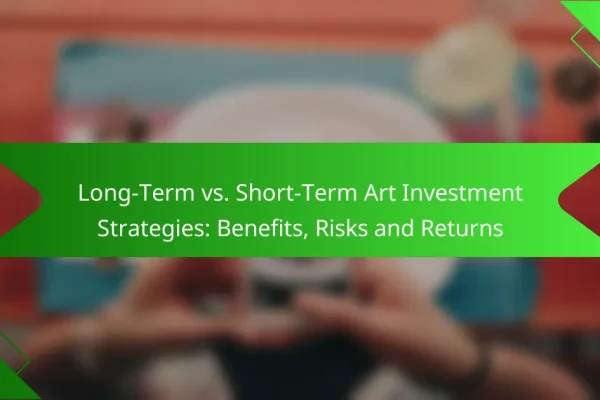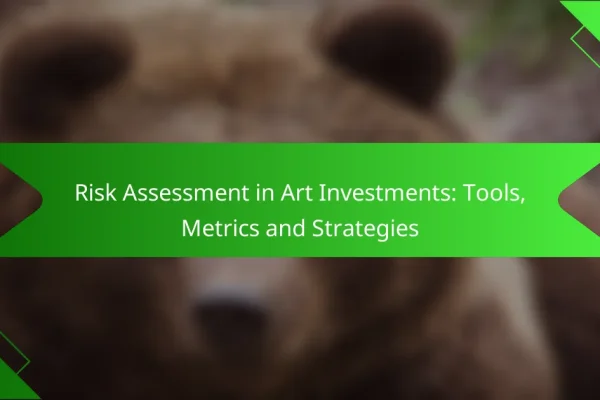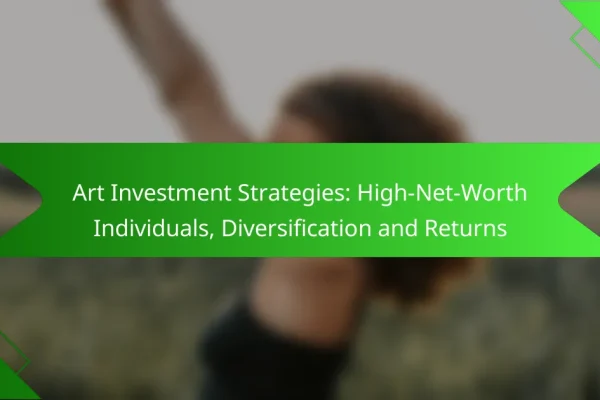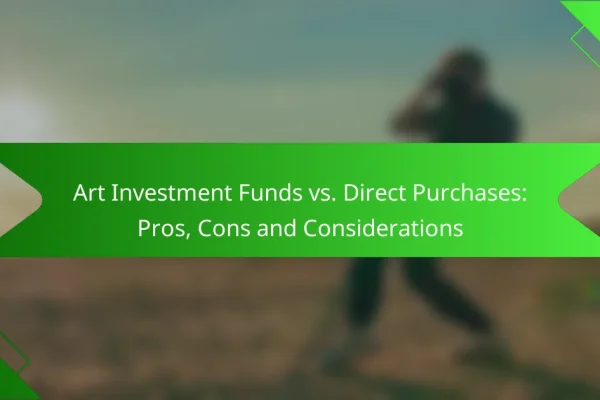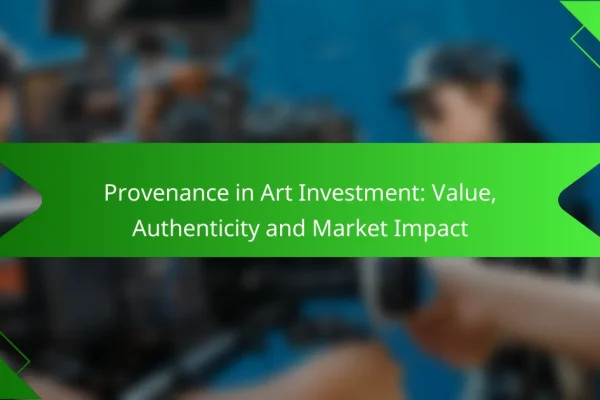What are effective art investment strategies in New York?
Effective art investment strategies in New York focus on understanding market trends, identifying valuable pieces, and leveraging local resources. Investors should consider various approaches, including acquiring contemporary art, supporting emerging artists, and participating in auctions to maximize their returns.
Contemporary art acquisitions
Contemporary art acquisitions involve purchasing works created by living artists, often reflecting current trends and cultural movements. This segment of the market can be volatile, but it offers significant potential for appreciation, especially for pieces by well-known artists. Investors should research artists’ backgrounds and market demand before making purchases.
When acquiring contemporary art, consider attending gallery openings and art fairs in New York, where many emerging talents showcase their work. Establishing relationships with galleries can provide insights into upcoming artists and trends.
Investing in emerging artists
Investing in emerging artists can yield high returns if the artist gains recognition and demand increases. This strategy requires a keen eye for talent and an understanding of the artist’s potential trajectory. Look for artists who have received awards, exhibited in reputable galleries, or have a growing social media presence.
Start by attending local exhibitions and art shows to discover new talent. Collecting works from emerging artists at lower price points can lead to significant appreciation if they become established in the art world.
Art funds and syndicates
Art funds and syndicates pool resources from multiple investors to acquire high-value artworks, allowing individuals to invest in pieces they might not afford alone. These funds typically focus on specific segments of the market, such as contemporary or modern art, and are managed by experts who make purchasing decisions on behalf of the investors.
Before joining an art fund, evaluate its track record, management team, and fee structure. Understand the fund’s strategy and how it aligns with your investment goals. This approach can diversify your portfolio while minimizing risk.
Participating in auctions
Participating in auctions is a dynamic way to acquire art, often allowing investors to purchase pieces at competitive prices. Major auction houses in New York, like Sotheby’s and Christie’s, regularly feature high-profile sales that can attract significant attention and bidding wars.
To succeed at auctions, familiarize yourself with the auction process, including registration, bidding increments, and buyer’s premiums. Set a budget and stick to it to avoid overspending in the heat of the moment.
Building a diverse collection
Building a diverse art collection involves acquiring works from various genres, styles, and periods to mitigate risk and enhance overall value. A well-rounded collection can appeal to a broader audience and increase the likelihood of appreciation over time.
Consider including a mix of contemporary, modern, and historical pieces, as well as works from different cultural backgrounds. Regularly reassess your collection to ensure it aligns with market trends and personal interests, and be open to selling pieces that no longer fit your strategy.
How to evaluate art for investment?
Evaluating art for investment involves assessing various factors that influence its value and potential return. Key considerations include provenance, market trends, artist reputation, and the condition of the artwork.
Provenance and authenticity
Provenance refers to the history of ownership of an artwork, which can significantly affect its value. Authenticity is equally crucial; artworks must be verified as genuine to command higher prices. Always seek documentation, such as certificates of authenticity or gallery records, to establish both provenance and authenticity.
When evaluating provenance, consider the artwork’s exhibition history and previous sales. A well-documented provenance can enhance an artwork’s desirability and market value.
Market trends and demand
Understanding current market trends and demand is essential for art investment. Research recent sales data, auction results, and gallery exhibitions to gauge which styles or artists are gaining traction. This information can help predict future value appreciation.
Pay attention to economic factors that may influence art sales, such as changes in disposable income or shifts in collector interests. Engaging with art market reports and attending art fairs can provide insights into emerging trends.
Artist reputation and history
The reputation and history of an artist play a significant role in determining the investment potential of their work. Established artists with a strong track record tend to have more stable values, while emerging artists may offer higher risk but potentially greater rewards.
Research the artist’s background, including their education, previous exhibitions, and critical acclaim. Collectors often favor artists with a strong narrative or unique style, which can enhance the artwork’s appeal and value.
Condition and quality assessment
The condition of an artwork directly impacts its value. Assessing quality involves examining the materials used, the craftsmanship, and any signs of damage or deterioration. Artworks in excellent condition typically command higher prices.
Consider hiring a professional conservator for a thorough evaluation if you’re unsure about the artwork’s condition. Regular maintenance and proper storage can also preserve an artwork’s quality, ensuring its value remains intact over time.
What are the risks of art investment?
Art investment carries several risks that potential investors should carefully consider. These include market volatility, liquidity challenges, high transaction costs, and the possibility of fraud or forgery.
Market volatility
The art market can experience significant fluctuations in value, influenced by trends, economic conditions, and collector demand. Prices for artworks can rise sharply during a boom but may also decline steeply during downturns.
Investors should be prepared for these changes and consider diversifying their portfolios to mitigate risks associated with market volatility. Keeping an eye on market trends and auction results can help gauge potential shifts.
Liquidity challenges
Art is not as liquid as other investments like stocks or bonds, meaning it can take time to sell a piece at a desired price. Finding a buyer willing to pay the right amount can be challenging, especially for niche artworks.
Investors should be aware that selling art may require patience and strategic marketing. Engaging with reputable galleries or auction houses can facilitate sales but may involve additional costs.
High transaction costs
Investing in art often involves substantial transaction costs, including auction fees, gallery commissions, and insurance. These costs can significantly reduce overall returns on investment.
Potential investors should factor in these expenses when evaluating the profitability of an art purchase. It’s advisable to negotiate fees and seek transparency from sellers to understand the full financial implications.
Fraud and forgery risks
The art market is susceptible to fraud and forgery, which can lead to significant financial losses. Unscrupulous sellers may misrepresent the authenticity or provenance of a piece, making due diligence essential.
Investors should work with trusted experts and conduct thorough research before purchasing artworks. Obtaining certificates of authenticity and provenance documentation can help mitigate these risks.
What are the tax implications of art investment?
Investing in art can have significant tax implications that investors should understand. These implications can affect capital gains, potential deductions for donations, and estate taxes, all of which can influence the overall profitability of art investments.
Capital gains tax considerations
When selling art, investors may be subject to capital gains tax on the profit made from the sale. This tax is typically calculated based on the difference between the sale price and the original purchase price. In the United States, collectibles, including art, are taxed at a maximum rate of 28%, which is higher than the standard capital gains tax rate for other investments.
To minimize capital gains tax, investors might consider holding art for over a year before selling, as this can sometimes qualify for lower long-term capital gains rates. Additionally, keeping detailed records of purchase prices and any associated costs can help in accurately calculating gains.
Tax deductions for donations
Donating art to a qualified charitable organization can provide significant tax deductions. The deduction amount is generally based on the fair market value of the artwork at the time of the donation. For example, if an artwork is valued at $10,000 at the time of donation, that amount can be deducted from the donor’s taxable income.
However, it is essential to obtain a qualified appraisal for artworks valued above a certain threshold, typically $5,000, to substantiate the deduction. Donors should also be aware of the IRS rules regarding the use of the donated art, as restrictions may affect the deduction amount.
Estate tax implications
Art investments can significantly impact estate taxes, as the value of the artwork is included in the total estate value upon death. In the U.S., estates valued above a certain threshold, which is subject to change, may incur estate taxes. This means that high-value art collections can lead to substantial tax liabilities for heirs.
To mitigate estate tax implications, investors may consider strategies such as gifting art to heirs during their lifetime or placing artworks in a trust. Both strategies can help reduce the taxable estate value and provide financial benefits to heirs.
How to build an art investment portfolio?
Building an art investment portfolio involves selecting a diverse range of artworks that align with your financial goals and risk tolerance. Focus on acquiring pieces from various artists, styles, and periods to mitigate risk and enhance potential returns.
Assess your budget and investment goals
Start by determining how much you are willing to invest in art. Consider your overall financial situation and set clear investment goals, whether they are short-term gains or long-term appreciation. A typical entry-level budget for art investments can range from a few thousand to tens of thousands of dollars.
Research and select artworks
Conduct thorough research on artists, art movements, and market trends. Look for artworks that have a history of appreciation or are by emerging artists with potential. Attend galleries, auctions, and art fairs to gain insights and discover new pieces.
Diversify your collection
Diversification is key to reducing risk in your art investment portfolio. Aim to include a mix of contemporary, modern, and classical works, as well as different mediums like painting, sculpture, and photography. This strategy can help balance potential losses in one area with gains in another.
Consider storage and insurance
Proper storage and insurance are essential for protecting your art investments. Ensure that artworks are stored in a climate-controlled environment to prevent damage. Additionally, invest in comprehensive insurance coverage to safeguard against theft, loss, or damage, which can be a significant expense depending on the value of your collection.
Stay informed and adapt
Art markets can be volatile, so staying informed about trends and changes is crucial. Regularly review your portfolio and be prepared to adapt your strategy based on market conditions and personal circumstances. Engaging with art advisors or joining investment groups can provide valuable insights and networking opportunities.
